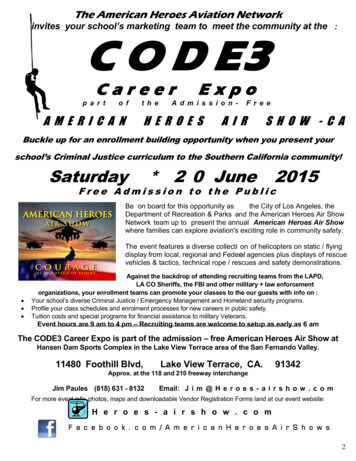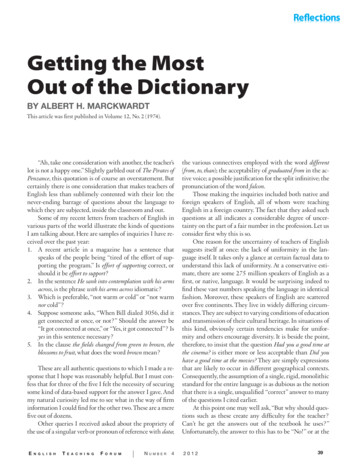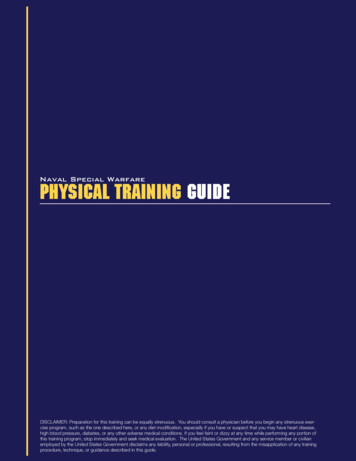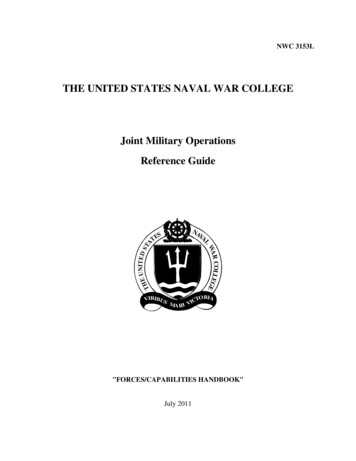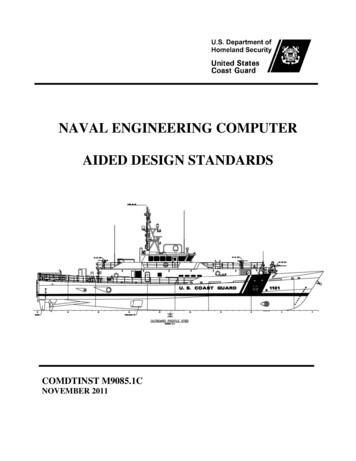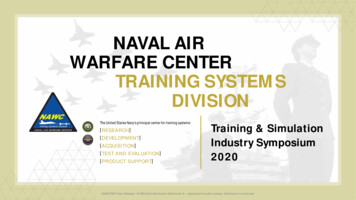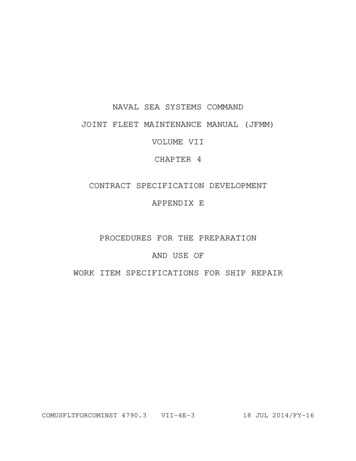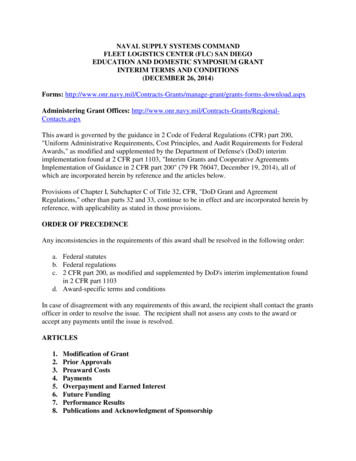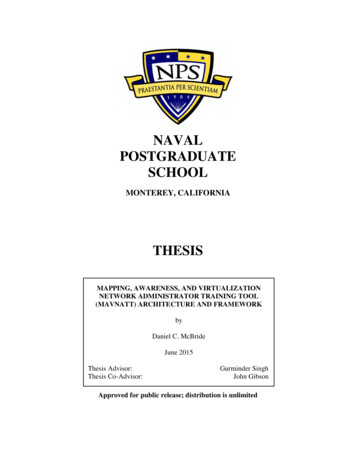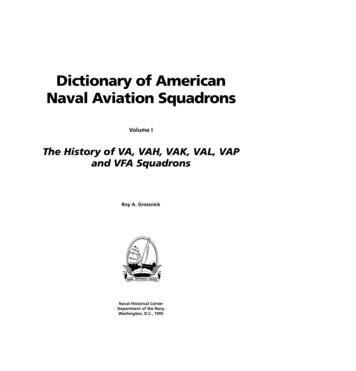
Transcription
382-018--Prelim Pgs. 4/6/95 10:34 AM Page i(Black plate)Dictionary of AmericanNaval Aviation SquadronsVolume IThe History of VA, VAH, VAK, VAL, VAPand VFA SquadronsRoy A. GrossnickNaval Historical CenterDepartment of the NavyWashington, D.C., 1995P. i no folio
382-018--Prelim Pgs. 4/6/95 10:34 AM Page ii(Black plate)Library of Congress Cataloging-in-Publication DataGrossnick, Roy A.Dictionary of American Naval Aviation Squadrons / by Roy A.Grossnick.p. cm.Contents: v. 1. The history of VA, VAH, VAK, VAL, VAP, andVFA squadronsISBN 0–945274–29–7 (v. 1)1. United States. Navy—Aviation—History. 2. Airplanes,Military—United States—History. I. Naval Historical Center(U.S.) II. Title. III. Title: American naval aviationsquadrons.VG93.G76 1995359.9’434’0973—dc2094–35647p. ii no folio
382-018--Prelim Pgs. 4/6/95 10:34 AM Page iii(Black plate)Secretary of the Navy’sAdvisory Committee on Naval HistoryWilliam D. Wilkinson, ChairmanCAPT Edward L. Beach, USN (Retired)David R. BenderJohn C. DannRADM Russell W. Gorman, USNR (Retired)Richard L. JoutrasVADM William P. Lawrence, USN (Retired)Vera D. MannAmbassador J. William Middendorf IIVADM Gerald E. Miller, USN (Retired)Clark G. ReynoldsBetty M. UnterbergeriiiP. iv blank
382-018--Prelim Pgs. 4/6/95 10:35 AM Page v(Black plate)About the AuthorROY A. GROSSNICK is currently a historianand head of the Naval Aviation History Office, abranch of the Naval Historical Center. He graduated from Wisconsin State University, StevensPoint, where he earned a Bachelor of Science inhistory in 1970. In 1972, Mr. Grossnick completed a Master of Arts in history at the Universityof Wisconsin, Madison. He served in the Navyon active duty for ten years. Following his separation from military service, Mr. Grossnickworked at the Smithsonian’s National Air andSpace Museum. In 1980, he assumed the historian position in the Naval Aviation History Office. Mr. Grossnick resides in Chevy Chase, Maryland,with his wife, Mary, and daughter Maki.He has written numerous articles for NavalAviation News magazine and was the author ofthe monograph Kite Balloons to Airships . . . the Navy’s Lighter-than-Air Experience,Volume 4 in a commemorative collection published in 1986 to mark the 75th anniversaryof naval aviation.Mr. Grossnick resides in Chevy Chase, Maryland, with his wife, Mary, and daughter Maki.vp. vi Blank
382-018--Prelim Pgs. 4/6/95 10:35 AM Page vii(Black plate)ContentsForeword / ixPreface / xiAcknowledgments / xiiiChapter 1The Evolution of Aircraft Class and SquadronDesignation Systems / 1Chapter 2Attack Squadron Histories (VA)/17VA-1E to VA-873Chapter 3Heavy Attack Squadron Histories (VAH)/295VAH-8 to VAH-123Chapter 4Tactical Aerial Refueling Squadron Histories (VAK)/303VAK-208 to VAK-308Chapter 5Light Attack Squadron History (VAL) /307VAL-4Chapter 6Heavy Photographic Squadron Histories (VAP)/ 309VAP-61 to VAP-62Chapter 7Strike Fighter Squadron Histories (VFA)VFA-15 to VFA-305vii/317
382-018--Prelim Pgs. 4/6/95 10:35 AM Page viii(Black plate)TitlePageAppendix1Aircraft Data—Technical Information and Drawings443Appendix2Aircraft Carrier Listing for CV, CVB, CVA, CVAN,CVN, CVL, and CVE Designations517Appendix3Carrier Deployments by Year521AppendixU.S. Navy Squadron Designations and Abbreviations537Appendix45How to Trace Squadron Lineage541Appendix6Lineage Listing for VA, VA(AW), VAH, VA(HM), VAK,VAL, VAP, and VFA Designated Squadrons543Appendix7Types of Aircraft Listed in Squadron Histories551Glossary of Abbreviations and Terms553Bibliography557Index of Squadron Histories and Aircraft Data561viii
382-018--Prelim Pgs. 4/6/95 10:35 AM Page ix(Black plate)ForewordGREAT CREDIT IS DUE TO ROY GROSSNICK andhis expert staff in the Naval Historical Center’sAviation History Branch for initiating a new publication series entitled the Dictionary of American NavalAviation Squadrons. The first volume of that series,which we are now publishing, includes approximately140 histories and other data covering every squadronin the attack (VA) and strike fighter (VFA) communitiesfrom the time the first of these commands (VA-35) wasestablished in 1934. This publication may be compared to the Dictionary of American Naval FightingShips, a nine-volume compilation of individual shiphistories published by the Naval Historical Centerbetween 1959 and 1991. Now, at long last, a basic reference work is under preparation that provides similardata for aviation commands.Subsequent volumes in this series will cover othercomponents of naval aviation. At the present time, theAviation History Branch is preparing a follow-on volume containing histories of all patrol squadrons of theU.S. Navy. This task is in addition to the many otherduties that office handles, including the writing of arti-cles for Naval Aviation News and responding to anincreasingly heavy load of official and unofficialrequests for information on all aspects of aviation history.History is a useful subject for the Navy for severalreasons. Insofar as it represents the sum total of theNavy’s experience, it is an essential subject for studyby naval professionals. History also is a means of giving an account to the American people of the activitiesof their Navy. Finally, since history allows naval personnel to learn about the origins, achievements, andtraditions of their commands and of the Navy as awhole, it is a powerful means to promote navalmorale. The Navy’s historians publish the first volumewith all of these purposes in mind. We hope this volume with be of interest and use to the active-dutyNavy and to many other individuals interested in thisnation’s rich naval heritage.Dean C. AllardDirector of Naval Historyixp x Blank
382-018--Prelim Pgs. 4/6/95 10:35 AM Page xi(Black plate)PrefaceTremaining six sections pertain to the evolutionary history of the squadron and includes listings of homeport assignments, commanding officers, aircraft assignments, overseas deployments, air wing assignmentsand major unit awards.This first volume covers the attack and strike fightercommunities and includes VA (attack squadron), VAH(heavy attack squadron), VAK (tactical aerial refuelingsquadron), VAL (light attack squadron), VAP (heavyphotographic squadron) and VFA (strike fightersquadron). Although VAK and VAP did not have a primary mission of offensive and defensive air-to-surfaceoperations, they are included here because thesesquadrons operated attack-designated planes, such asthe AJ-2 and the A-3 and its derivatives. The squadronhistories in this volume cover only those squadronsthat are currently designated VA or VFA or those thathad the VA, VAH, VAK, VAL, VAP and VFA designationswhen they were disestablished. Any attack squadronredesignated VF, VS, RVAH, VAQ or VAW that did notrevert back to VA is not in this volume. The lineagelisting in Appendix 6 provides a cross reference list forall squadrons that may have had the VA, VA(AW), VAH,VA(HM), VAK, VAL, VAP and VFA designation.Reserve squadron histories begin in 1970 followingthe reorganization of the Naval Air Reserve Force.Prior to that time reserve air squadrons were not permanently assigned aircraft. During weekend drills theyused aircraft from their local naval air station. This pre1970 organizational system, combined with the factthat these squadrons provided no permanent historicalrecords, makes it difficult to trace its activities. Hence,histories on reserve squadrons prior to 1970 coveronly those squadrons called to active duty andassigned their own aircraft.Histories for active squadrons cover the period fromestablishment up through 1990, an arbitrary cutoffdate. If a squadron was redesignated or disestablishedafter 1990, its history is updated to its redesignation ordisestablishment date.HE DICTIONARY OF AMERICAN NAVAL AVIATIONSQUADRONS, the first of a multivolume series, provides a brief history, by community, of every squadronthe Navy has established since the evolution of thesquadron concept in the post-World War I era. Theinformation and format selected to tell the story ofeach squadron was developed from a pattern of common reference questions. The nature of the squadrondata lends itself to a variety of formats for most entriesin the squadron histories instead of a straight narrativestyle. The dictionary, written primarily for use as a reference work, states concise facts about each squadronthat provide a better understanding of the contributions made by naval aviation squadrons in service totheir country.Naval aviation is primarily a twentieth century development and has become an important element of U.S.sea power. It is part of the technological revolution thathas been the hallmark of the twentieth century. The aircraft, weapons systems and associated technical equipment, combined with the men and women assigned tothe squadrons, are instrumental to its success.Each squadron history begins with a lineage sectionthat starts with the date of establishment. It alsoincludes any redesignations and disestablishment dateif applicable. The squadron’s establishment date maybe equated to a ship’s commissioning and the historyfor a squadron or ship begins on that date. When asquadron is redesignated, there is no break in the history of that squadron. The history of a squadron covers the period from its establishment to its disestablishment, regardless of how many redesignations itundergoes. Redesignations can cause confusion whentracing the lineage of a squadron. For more information on how to trace squadron lineages, please refer toAppendix 5.A short description and photograph for all officiallyapproved insignia used by a squadron follows the lineage section. The chronology narrates the squadron’simportant operational events and developments. Thexi
382-018--Prelim Pgs. 4/6/95 10:35 AM Page xii(Black plate)Most illustrations used in the book are official U.S.Navy photographs unless otherwise identified. If available, a photograph is included for each major type ofaircraft operated by a squadron.Extensive appendices not only provide additionalstatistical material but also help to clarify or explainthe Navy’s unique organization and use of acronymsor designations.When drafting a reference work with such an extensive range of data, it is almost impossible to preventerrors. An exhaustive effort was made to check thecompilation of material presented in this book. Whendifferent sets of records or sources provided conflicting dates, I attempted to select the most accurate onebased on my research. In some cases only a specificyear could be determined. As the writer and majorcompiler of the data for this volume, I accept fullresponsibility for any mistakes or errors of fact or misinterpretations that may have occurred in the book,and I welcome any corrections.Roy A. Grossnickxii
382-018--Prelim Pgs. 4/6/95 10:35 AM Page xiii(Black plate)AcknowledgmentsICONCEIVED THIS BOOK AFTER eight years ofworking in the Naval Aviation History Office. A common request received by the office was for a completehistory of a particular squadron. Realizing the need fora history of all naval aviation squadrons prompted thedevelopment of a format that would meet the requirements posed by the Navy and most people requestinginformation on a squadron. Using the Dictionary ofAmerican Fighting Ships as an example of an excellentprimary reference source, I patterned my approachalong lines similar to that series.I am very grateful for the guidance and support provided by many individuals and organizations that wereinstrumental in making this book possible. The initialsupport I received from Captain Steven U. Ramsdell, USN(Ret.), former Director, Naval Aviation History andPublications Division, in getting this project off theground was one of the keys to the successful completionof the book. He provided valuable comments in hisreviews of the draft histories. His successors, CommanderStephen R. Silverio, USN (Ret.) and Commander MichaelS. Lipari, continued in his footsteps, providing reviewrecommendations as well as support for the project.The personnel in the Naval Aviation History Office,Ms. Gwen Rich, Ms. Judith Walters and Mr. Steven Hill,were my prime supporters in writing the book. Specialthanks go to Mr. John M. Elliott, retired historian from theoffice, for his recommendations, and providing the aircraft line drawings for Appendix 1, as well as other assistance in getting the book ready for publication. The stafffrom the Naval Aviation News Branch, filled the editorialrole. The manuscript was reviewed several times by Mrs.Sandy Russell and Ms. Joan A. Frasher. Mr. Charles C.Cooney provided design support for the squadron format, as well as extensive photographic support.I would also like to recognize Naval Historical Centeroffices that made their records available. First, and foremost, was the Operational Archives Branch. Mrs.Kathleen M. Lloyd and members of her Research andReference Section, as well as Mrs. Judith W. Short, werealways willing to make that extra effort to find the documents I needed for the book. Mr. John C. Reilly andthe Ships’ Histories Branch was always there to providedocumentation regarding a particular carrier. The staffof the Navy Department Library was particularly helpfulwhen I reviewed their collection of cruise books. ThePhotographic Section of the Curator Branch, particularlyMr. Edwin C. Finney, Jr., was always responsive to myneeds for particular aircraft photographs. The servicesprovided by Ms. Sandra J. Doyle, the Naval HistoricalCenter’s senior editor, are also appreciated.The advice, information and comments offered bypersonnel outside the Naval Historical Center warrantspecial attention. Mr. Harold Andrews, Captain Rosario(Zip) Rausa, USN (Ret.), and Captain Kenneth L.Coskey, USN (Ret.), reviewed sections of the manuscript and provided valuable recommendations. A veryspecial thank you goes to Vice Admiral William P.Lawrence, USN (Ret.), a member of the Secretary ofthe Navy’s Advisory Committee on Naval His
Dictionary of American Naval Aviation Squadrons Volume I The History of VA, VAH, VAK, VAL, VAP and VFA Squadrons Roy A. Grossnick Naval Historical Center Department of the Navy Washington, D.C., 1995 P. i no folio 382-018--Prelim Pgs. 4/6/95 10:34 AM Page i (Black plate) Library of Congress Cataloging-in-Publication Data Grossnick, Roy A. Dictionary of American Naval Aviation Squadrons /
